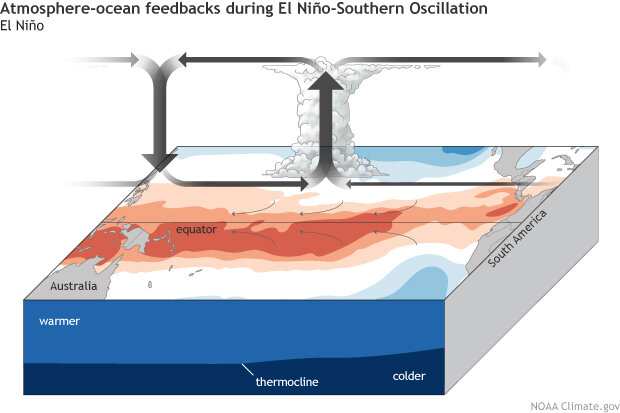MADISON—For years, the prevailing belief among climate scientists was that Earth’s tilt was the primary factor in determining seasonal climate in the tropical Pacific.
But new research from scientists at the University of Wisconsin–Madison and several other institutions around the world highlights an overlooked factor that has an equally important role: the “distance effect” of Earth’s orbit, which affects the planet’s proximity to the sun.
“You’d think that our understanding of the seasons is pretty well established. But right on the equator in the tropical Pacific, we have a lot of trouble simulating the seasonal cycle,” says Daniel Vimont, a climate scientist at UW–Madison and collaborating author of the paper.

He explains that closing this gap is important for understanding the tropical Pacific because it’s a critical region that influences the rest of Earth’s climate system.
For instance, it’s where El Niño occurs, a climate pattern Vimont describes as the biggest thing that can happen in Earth’s climate system on year-to-year time scales. During El Niño events, winds push warm water from the Western Pacific toward the Eastern, bringing with it warmer surface conditions, and decreased upwelling of nutrient-rich, cold water that affects what marine species can flourish where.
Since the ocean and atmosphere are also connected, when warm water and clouds move from west to east during a climate event like El Niño, it changes the weather that happens on a global scale, too.
The equator is also the perfect place to isolate the impact of the Earth’s orbit from its tilt since the effects of the Earth’s tilt are minimized on the equator (the effects are strongest at the poles).
Vimont and his lab were already modeling this ocean-atmosphere connection when they were asked to join the study led by John C. H. Chiang of the University of California, Berkeley, which was recently published in Nature. The researchers revealed that both the “tilt effect” and the “distance effect” play equally important roles in influencing climate seasonality in the Pacific.
It just so happens that in the tropical Pacific’s current climate the two cycles are aligned, obscuring the full weight of influence the distance effect has and making it seem like the Earth’s tilt had an outsized role in determining the seasons.
For the study, Vimont used computer simulations to “break the physics” of the real world to model how the ocean and the atmosphere interact and influence the timing of the seasonal cycle in the tropical Pacific. He was also interested in determining what processes are vital to creating our climates.
“The atmosphere and the ocean interact with each other by means of exchanging heat. But they also exchange momentum, so the atmosphere can push on the ocean,” Vimont says. “So, one thing you might do is say, ‘Well, I’m not going to let the atmosphere push on the ocean.’”
By using models to toggle different processes on and off, climate scientists can get a sense for which processes influence climate. In this case, they found that the atmosphere and ocean pushing on each other is important in creating the climate on the tropical Pacific.
“That’s important because as we look back in the past, this new finding suggests we should revisit model simulations and paleoclimatic data that we use to infer past behavior of the tropical Pacific,” Vimont says.
Since the Earth’s orbit is elliptical and changes through time, that means in the past this second seasonal cycle driven by the Earth’s distance from the sun could have been timed differently from the cycle driven by the Earth’s tilt.
These results provide a chance to test global climate model simulations of past changes to climate. While natural climate cycles caused by Earth’s orbit and tilt have long existed and influenced the planet, the changes driven by human influences since the start of the industrial era cannot be explained by these natural cycles.
Understanding how these human influences alter the Earth’s climate in the future is another focus of climate scientists. They use models of past climates to project and plan for the future, so improving scientific understanding of these models of the past is particularly important.
“This study is a great opportunity to push our understanding of the tropical Pacific, which we know affects the rest of the world,” Vimont says.








